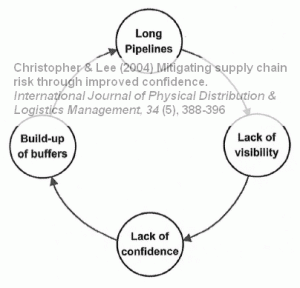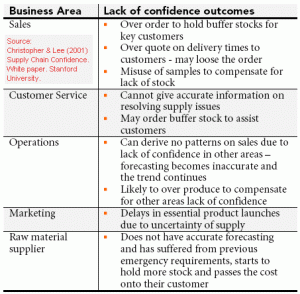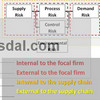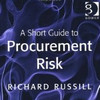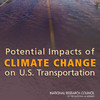 Did a 2001 white paper turn into a 2004 academic journal article just like that? In Mitigating supply chain risk through improved confidence, Martin Christopher and Hau Lee explore the impact confidence has on supply chain performance. Although difficult to precisely quantify, the confidence factor can have significant impact on inventory levels and operating costs, they say. Interestingly this 2004 article also appears as a 2001 white paper on supply chain confidence published by the Stanford Global Supply Chain Management Forum. Is the journal article just a re-published white paper?
Did a 2001 white paper turn into a 2004 academic journal article just like that? In Mitigating supply chain risk through improved confidence, Martin Christopher and Hau Lee explore the impact confidence has on supply chain performance. Although difficult to precisely quantify, the confidence factor can have significant impact on inventory levels and operating costs, they say. Interestingly this 2004 article also appears as a 2001 white paper on supply chain confidence published by the Stanford Global Supply Chain Management Forum. Is the journal article just a re-published white paper?
Original or not?
 According to the date on the front page, the white paper, boldly titled Supply Chain Confidence: The Key to Effective Supply Chains Through Improved Visibility and Reliability, was published in 2001 and bears the logo of Vastera, a provider of global trade management solutions (Sidenote: Vastera was acquired by JP Morgan Chase in 2005).
According to the date on the front page, the white paper, boldly titled Supply Chain Confidence: The Key to Effective Supply Chains Through Improved Visibility and Reliability, was published in 2001 and bears the logo of Vastera, a provider of global trade management solutions (Sidenote: Vastera was acquired by JP Morgan Chase in 2005).
In 2004, the same paper appeared in the International Journal of Physical Distribution & Logistics Management under a more toned down and perhaps academically more profound title: Mitigating supply chain risk through improved confidence. A few sentences are reworked here and there, and some sales pitch like phrases are omitted, but essentially, it is word-by-word the exact same paper.
Which is the original? Is perhaps the date on the white paper wrong? Usually white papers come after or based on journal articles. I first thought so, since the journal articles references articles published in 2002 and 2003, which could not be the case if the white paper really was written in November 2001, as the front page states. However, if I am to believe the date stamp on the pdf-version of the white paper on the Stanford website, it was indeed created in April 2002, which only makes sense if it was written prior to that date.
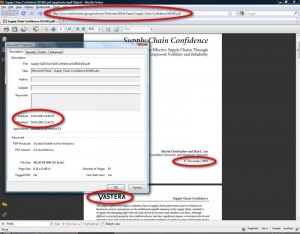 Click image for larger version
Click image for larger version
The proof is in the pudding, that is the Internet itself. According to archive.org the white paper does appear on the April 2002 version of the Stanford Global Supply Chain Management Forum website. While I see nothing wrong with re-writing a white paper into a journal article, I’m just baffled as to why it is not mentioned in the references for the journal article. But anyway, let’s take a closer look at the paper itself, because it is quite interesting.
Sources of risk
Traditionally, papers on supply chain risk use the “classic” supply-demand-internal-external scheme for classifying supply supply chain risk sources. Christopher and Lee do not. They see risk as primarily related to uncertainty, volatility and turbulence, similar to the notion of supply chain risk in turbulent environments that I found in Trkman and McCormack (2009), which I reviewed back in October.
Christopher and Lee relate supply chain risk to
- financial risks
- inventory overstocking
- markdowns
- stock-outs
- obsolescence
- chaos risks
- overreactions
- unnecessary interventions
- second guessing
- mistrust
- distorted information
- decision risks
- uncertainty of making the right decisions
- uncertainty of making the wrong decisions
- market risks
- changes in global/local trends
- changes in customer preferences
- existing and new market opportunities missed
The list is not meant to be exhaustive, but only meant to be examples of risks that contribute negatively towards supply chain confidence.
Lack of confidence
The key issue is that beyond the physical and tangible risks are many more (and worse) intangible risks, represented by the attitudes and perceptions of the users and members of the supply chain:
The intangible lack of confidence in a supply chain leads to actions and interventions by supply chain members, which collectively, could increase the risk exposure.
Bottom line: the higher the uncertainty, the lower the confidence. Typical issues are no confidence in:
- Order cycle time
- Order current status
- Demand forecasts given
- Suppliers’ capability to deliver
- Manufacturing capacity
- Quality of the products
- Services delivered
This lack of confidence is what drives a risk spiral, where globalization and outsourcing lead to long pipelines, pipelines that more often than not lack the necessary visibility and control, which leads to an excessive reliance on inventory buffers, creating perhaps even longer pipelines, since the resources have already been stretched for working on the first inventory buffer.
Click image for larger version
The article lists a number of issues that can occur when lack of visibility and lack of control lead to a lack of confidence:
Click image for larger version
In order to restore supply chain confidence, the two basic elements of supply chain confidence must be addressed: control and visibility.
Total end-to-end visibility will enable supply chains to be transparent, and the right information would be available to the right member of the supply chain at the right time.
Both visibility and control are critical for restoring supply chain confidence. Which one that is needed most, control or visibility, that depends on the on-time performance and lead time of the supply chain:
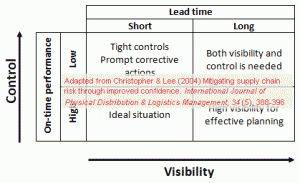 Click image for larger version
Click image for larger version
The paper mentions three key levers for breaking the risk spiral:
Information Accuracy, Visibility and Accessibility
Throughout the supply chain, key operational metrics and status must be accessible by key members of the supply chain.
Alerts for Out of Control Conditions
Any time when deviations from the plan have occurred, the appropriate parties of the supply chain have to be alerted.
Responsive Corrective Actions
All members of the supply chain need to have contingency plans and tools to make corrective actions when out of control conditions have been detected.
With all this place, the ground is prepared for what Christopher and Lee call the synchronous supply chain, where all activities are (as the name implies) fully synchronized. This is what makes a supply chain agile.
Synchronous supply requires transparency of demand and pipeline inventory in as close to real time as possible. The ability to match supply more closely with demand we call agility and the key to agility is speed.
That is a definition of agility that is different from the one I adhere to, where I see agility, flexibility, robustness and resilience as separate and different terms.
Conclusion
Supply Chain Confidence is an interesting concept. In this paper confidence is based on visibility and control. The framework makes sense, and is supported by real-life (albeit anecdotal) examples. However, I haven’t come across any later and notable research on supply chain confidence. Only one comes to my mind, Diana Esparza, a student at the University of Ottawa, who according to a blog post on Procurement Insights wrote her Master’s thesis on the topic of Supply Chain Confidence. I wonder how that went…
Reference
Christopher, M., & Lee, H. (2004). Mitigating supply chain risk through improved confidence International Journal of Physical Distribution & Logistics Management, 34 (5), 388-396 DOI: 10.1108/09600030410545436
Read online
- stanford.edu: Supply Chain Confidence
Author Links
- martin-christopher.info: Martin Christopher
- stanford.edu: Hau Lee
Related
- husdal.com: Supply chain risk in turbulent environments
- husdal.com: The IBM Supply Chain of the Future
- husdal.com: Business Intelligence and Supply Chain Risk

